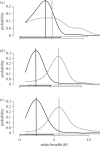Host specialist clownfishes are environmental niche generalists
- PMID: 25274370
- PMCID: PMC4213602
- DOI: 10.1098/rspb.2013.3220
Host specialist clownfishes are environmental niche generalists
Abstract
Why generalist and specialist species coexist in nature is a question that has interested evolutionary biologists for a long time. While the coexistence of specialists and generalists exploiting resources on a single ecological dimension has been theoretically and empirically explored, biological systems with multiple resource dimensions (e.g. trophic, ecological) are less well understood. Yet, such systems may provide an alternative to the classical theory of stable evolutionary coexistence of generalist and specialist species on a single resource dimension. We explore such systems and the potential trade-offs between different resource dimensions in clownfishes. All species of this iconic clade are obligate mutualists with sea anemones yet show interspecific variation in anemone host specificity. Moreover, clownfishes developed variable environmental specialization across their distribution. In this study, we test for the existence of a relationship between host-specificity (number of anemones associated with a clownfish species) and environmental-specificity (expressed as the size of the ecological niche breadth across climatic gradients). We find a negative correlation between host range and environmental specificities in temperature, salinity and pH, probably indicating a trade-off between both types of specialization forcing species to specialize only in a single direction. Trade-offs in a multi-dimensional resource space could be a novel way of explaining the coexistence of generalist and specialists.
Keywords: anemone; anemonefish; intraspecific variation; mutualism; trade-off.
© 2014 The Author(s) Published by the Royal Society. All rights reserved.
Figures


References
-
- MacArthur RH. 1972. Geographical ecology: patterns in the distribution of species. New York, NY: Harper & Row.
-
- Levins R. 1963. Theory of fitness in a heterogeneous environment. II. Developmental flexibility and niche selection. Am. Nat. 97, 75–90. (10.1086/282258) - DOI
-
- Lawlor LR, Maynard Smith J. 1976. The coevolution and stability of competing species. Am. Nat. 110, 79–99. (10.1086/283049) - DOI
Publication types
MeSH terms
Substances
Associated data
- Actions
- Actions
- Actions
- Actions
- Actions
- Actions
- Actions
- Actions
- Actions
- Actions
- Actions
- Actions
- Actions
- Actions
- Actions
- Actions
- Actions
- Actions
- Actions
- Actions
- Actions
- Actions
- Actions
- Actions
- Actions
- Actions
- Actions
- Actions
- Actions
- Actions
- Actions
- Actions
- Actions
- Actions
- Actions
- Actions
- Actions
- Actions
- Actions
- Actions
- Actions
- Actions
- Actions
- Actions
- Actions
- Actions
- Actions
- Actions
- Actions
- Actions
- Actions
- Actions
- Actions
- Actions
- Actions
- Actions
- Actions
- Actions
- Actions
- Actions
- Actions
- Actions
- Actions
- Actions
- Actions
- Actions
- Actions
- Actions
- Actions
- Actions
- Actions
- Actions
- Actions
- Actions
- Actions
- Actions
- Actions
- Actions
- Actions
- Actions
- Actions
- Actions
- Actions
- Actions
- Actions
- Actions
- Actions
- Actions
- Actions
- Actions
- Actions
- Actions
- Actions
- Actions
- Actions
- Actions
- Actions
- Actions
- Actions
- Actions
- Actions
- Actions
- Actions
- Actions
- Actions
- Actions
- Actions
- Actions
- Actions
- Actions
- Actions
- Actions
- Actions
- Actions
- Actions
- Actions
- Actions
- Actions
- Actions
- Actions
- Actions
- Actions
- Actions
- Actions
- Actions
- Actions
- Actions
- Actions
- Actions
- Actions
- Actions
- Actions
- Actions
- Actions
- Actions
- Actions
- Actions
- Actions
- Actions
- Actions
- Actions
LinkOut - more resources
Full Text Sources
Other Literature Sources

